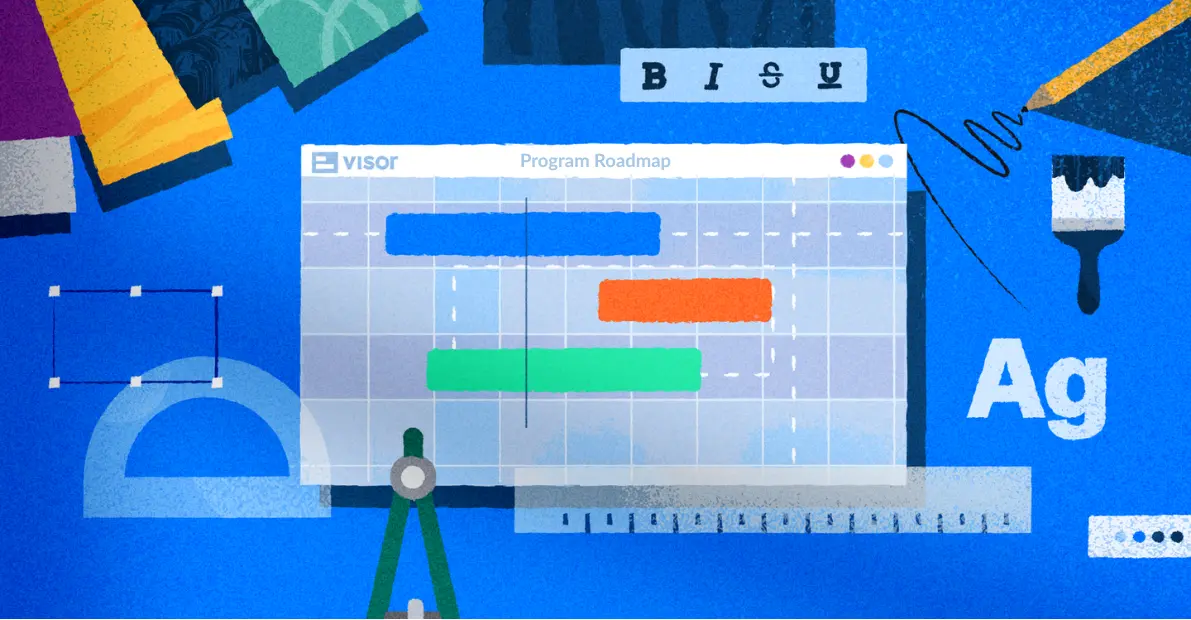
Best Product Roadmap Tools For Better Product Management 2025
Finding the best product roadmap tool for you can be confusing, time-consuming, and frustrating.
There are so many potential options to consider and, if you’re like most people, you don’t have the time to make a detailed assessment yourself.
To help you, I’ve spent hours researching, trialing, testing, and comparing all the top roadmapping software and created this detailed evaluation of the best product roadmapping tools.
By leveraging my research, you can save a significant amount of time and effort. This will enable you to make a more informed, confident decision about the right software for you.
Looking for a better way to manage every project in your portfolio, from roadmaps to after action data? Check out Visor- free!
If you work in a Jira team, be sure to explore my analysis of the best product roadmap tool for Jira at the end of this blog.
The Best Product Roadmap Tools
- Visor
- Roadmunk
- ProductPlan
- Asana
- Prodpad
- Productboard
Note: Many of these tools are functional for both project and product roadmapping. While two different things in practice, both of these tasks can and often do use overlapping tools. We’re focusing on product roadmapping tools in this article, but you can check out one of our many other guides for project roadmapping if that’s what you’re after!
1. Visor
Our list kicks off with Visor, a project portfolio management tool that
Visor thrives when used in partnership with systems like Jira, through its uniquely strong and reliable integrations. Roadmaps in Visor look fantastic, are flexible, and are fully customizable. Sharing is easy and there’s a wide range of settings you can apply to create different views for different audiences and take control over the information
Note that Visor doesn’t have some of the additional feedback and prioritization features you’ll find in other roadmapping tools. But for creating and sharing impactful, resonant roadmaps and integrating seamlessly with apps like Jira, it is in a league of its own.
Roadmapping
Roadmaps in visor are presentable in fully customizable views (including boards with swimlanes, timelines, Gantt charts, and spreadsheets) all using the same underlying data.
The process of creating roadmaps is incredibly easy, and the level of customization makes it possible to build different views that are highly specific to certain teams or stakeholders.
Here’s an example of an Epic level roadmap I created in Visor using my Jira data:

Sharing roadmaps
The various views you create in Visor are modifiable using filters, colorful formatting, and custom fields. To highlight, show, and hide different information in each view, for different stakeholders, teams, or purposes. You can also lock down views before sharing to prevent any unintended changes from your colleagues.
Sharing is really easy, either by adding people’s email addresses, or creating a reusable sharable link. You can apply permissions for viewing, commenting, or editing at a link level too.
All plans (even the free plan) come with unlimited viewers. This differentiates Visor from other options on this list that throttle how many viewers/reviewers you can have, which either restricts your ability to share your roadmaps, or increases your expenditure.
Ease of Use
Creating, sharing, and editing roadmaps is incredibly easy in Visor. Roadmap elements are dragged and dropped into place, and you can add details to them in a click. Whereas other roadmapping tools can feel clunky or fiddly, Visor feels smooth and reliable.
The UI is clean and uncluttered so you shouldn’t experience much of a learning curve and can get your roadmap created faster.
You can see how the drag and drop functionality works in the image below:

Integrations
Visor’s integrations are especially strong and seem to be unrivaled. It overcomes many of the shortcomings of other roadmapping tools’ integrations with systems like Jira.
For example, Visor’s integration with Jira preserves all the nested hierarchies and relationships between different tasks. In many other systems (e.g. Roadmunk) this is not the case, and means you need to manually reconnect your tasks and sub-tasks, epics and issues and so on.
Visor also retains the characteristics of each field, such as the character limits, character types and symbols, and dropdown options. Again, this is a unique strength and prevents lots of syncing errors and manual fixing you’ll encounter with other roadmapping software.
Visor doesn’t charge you the earth for this either. The two-way integration with Jira is included with our free plan! As you’ll see this is a much more generous and open policy than other systems are willing to provide.
Pricing
Free: $0
Starter: $9 per editor per month*
Pro: $18 per editor per month*
Two-way integrations are included as standard on all plans, even including the Free plan!
2. Roadmunk
Roadmunk is one of the most advanced product roadmapping tools available. Users of simpler roadmapping software (such as ProductPlan) will find it much more feature-rich, but can expect to experience a steep learning curve, too.
Roadmunk includes feature feedback and prioritization functionality, which knits together an important part of the product roadmapping process. Roadmunk could be a high-powered, sophisticated addition to your wider product management tech stack.
Roadmapping
Roadmunk comes equipped with a range of roadmapping templates to help you get started, and you can build roadmaps in both timeline and swimlane views. The roadmaps themselves aren’t that visually impressive (the UI is a bit gray, blocky and dated), but everything is clear and easy for viewers to understand.
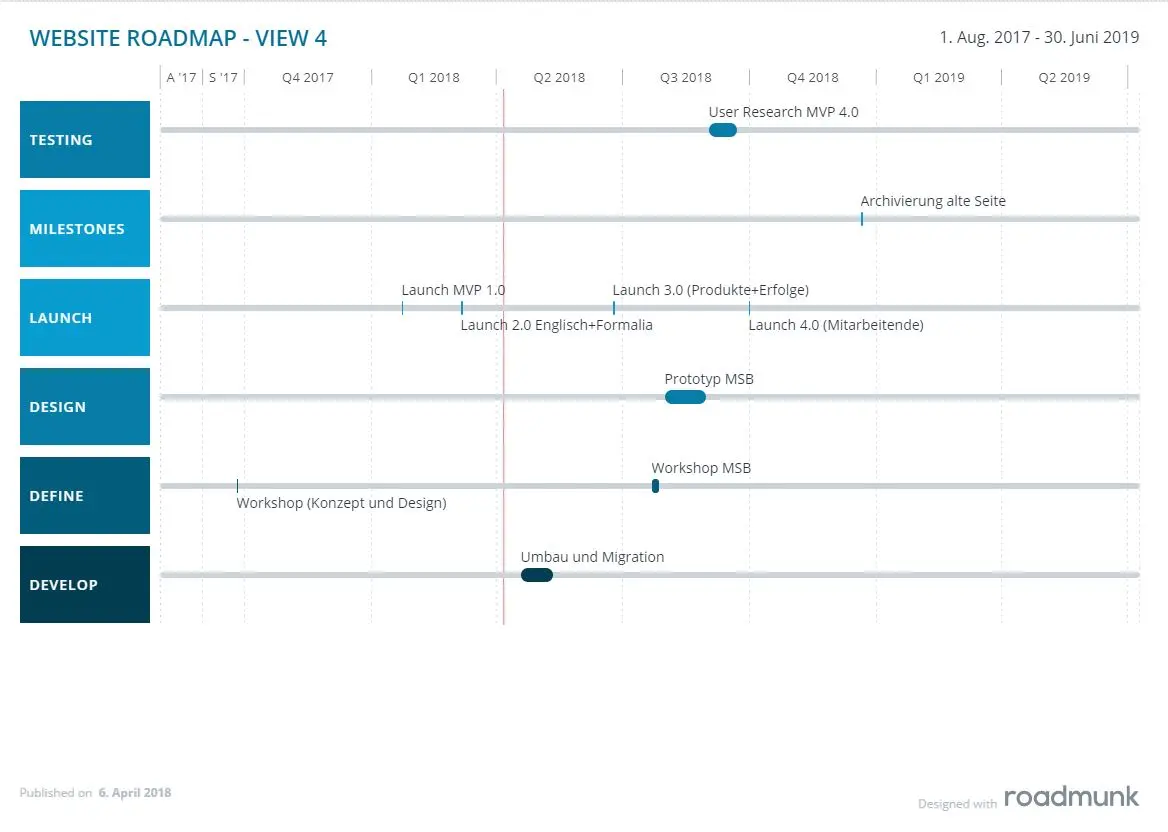
Image via Roadmunk
One of Roadmunk’s key differentiators is the ability to pivot your roadmap’s lanes based on different fields. For example, you can pivot by different team members to see what each person needs to deliver.
You can also pivot by theme, sprints, or epics, giving you a different perspective on how work meets wider goals, and enabling you to provide bespoke views to different stakeholders, teams, or for different meeting agendas.
Another cool feature is being able to “roll up” multiple roadmaps into one. This gives you a roadmap portfolio view that many products lack, even dedicated product roadmapping tools. This is perfect if you’re managing a big portfolio, or working at a large organization that needs to provide overviews to senior management.
Sharing Roadmaps
With Roadmunk you can create fairly customized views using filters, headers, and lane pivoting that I’ve explained above. You can share views via email invites, but you can’t create shareable links, which can make things a bit laborious and repetitive.
Each pricing plan also has a maximum number of reviewers per account* which is pretty restrictive given the amount of money you are paying already.
*Maximum of three reviewers in the Starter plan, which is $19 per month, to ten reviewers in the Professional plan which is $99 per editor per month).
Ease of Use
Building roadmaps in Roadmunk is technically straightforward, with drag and drop functionality. However, the complexity and number of options may be overwhelming for new users.
Some users and reviewers also report performance issues, and complain about having to click through many steps to make relatively simple changes.
This is the story of Roadmunk: really advanced, and complex, but prone to slow down and over complicate simple steps.
Integrations
Roadmunk only has ready-to-use integrations with Jira and Azure DevOps, giving it a real weakness compared to its competition. In addition, a two-way integration with Jira/Azure DevOps is only available with the higher-level plans (starting at $49 per editor per month). On top of this you’ll need to pay $9 extra per collaborator per month (see Roadmunk’s full pricing).
When you import data from Jira to Roadmunk you’ll lose your nested hierarchies (e.g. tasks and sub-tasks) which is a real pain and time consuming. It doesn’t support Jira custom fields either. I’ve written a more in-depth explainer of Roadmunk’s integration with Jira that I’d recommend you read.
Pricing
Starter: $19 per month
Business: $49 per editor per month
Professional: $99 per editor per month
3. ProductPlan
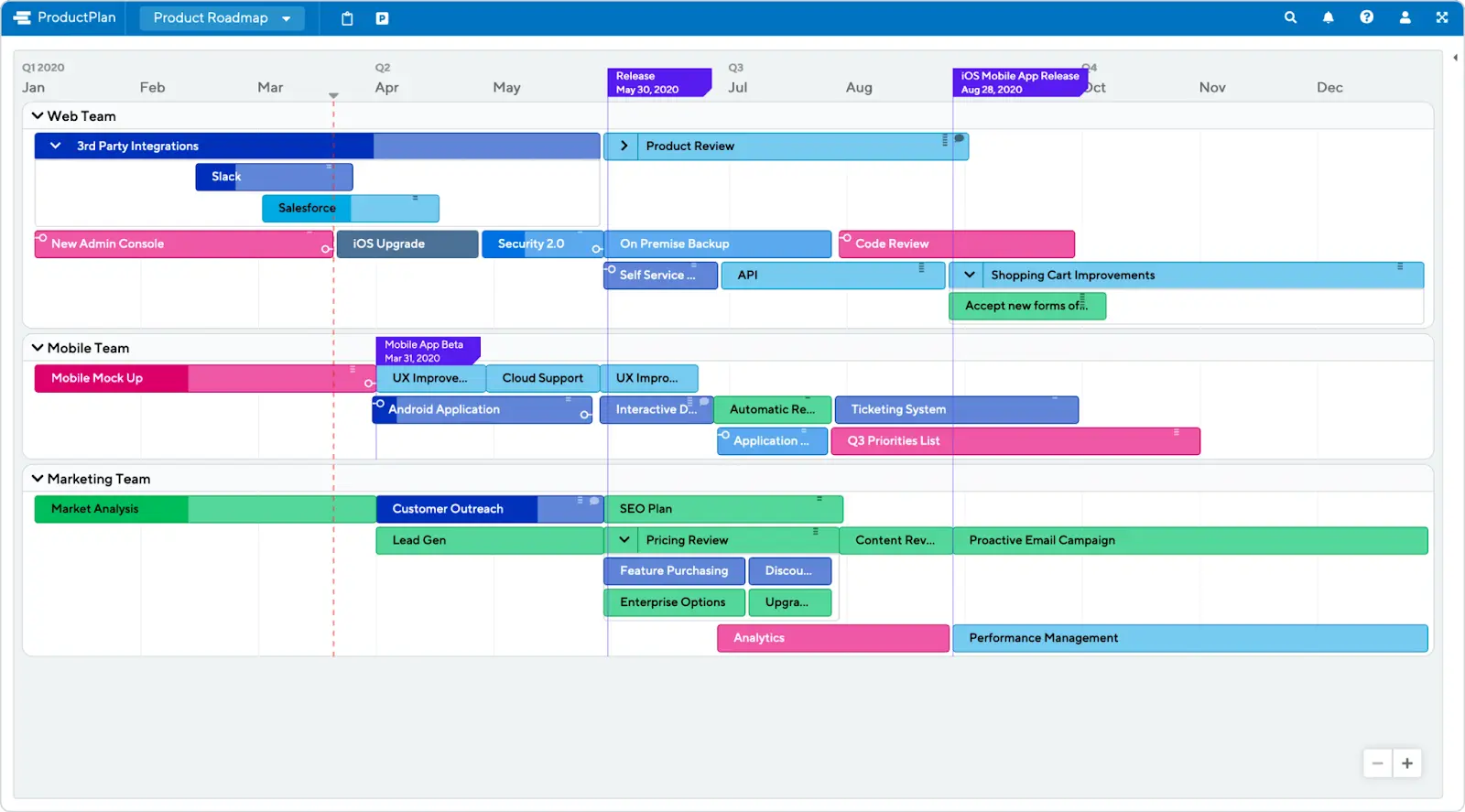
Image via Productplan
ProductPlan is a really easy to use roadmapping tool. Its roadmapping functionality is less advanced than systems like Roadmunk. It doesn’t have additional features such as feedback management to support roadmapping either. But what it lacks in bells and whistles it makes up for in being lightweight, simple, and fast.
If you’re trying to decide whether Roadmunk and ProductPlan is better for you then read my comparison: Roadmunk vs. Productplan.
Roadmapping
ProductPlan makes creating roadmaps easy with a simple, drag and drop interface that’s really intuitive. Milestones on roadmaps are easy to add and track. Their customization options are wide-reaching and easy, more so than in many alternatives.
Custom filters and tagging make it easier for you to segment information and create filtered views based on criteria specific to your organization, team, or project. You don’t need to ration yourself, either, as there’s no maximum number of roadmaps you can build.
Things can look a little messy when your roadmap becomes more complex and the UI, although clear, could do with a bit of refresh to bring it into the 2020s.
Sharing Roadmaps
Sharing roadmaps is straightforward in ProductPlan, with a few minor limitations. You can share roadaps via email invite or a shareable link, with viewer or editor access. You can also create private links which don’t require a viewer to sign in to view, and embed these on websites and other suitable locations. This is great for sharing with people outside your organization.
You’ll need a Professional or Enterprise plan (starting at $89 per editor per month) if you want to share with your whole organization at once.
Ease of Use
Ease of use is ProductPlan’s core strength. Templates help get your roadmap in motion, and it’s very easy to build and customize thereafter. While you can’t do everything in ProductPlan that you can in other roadmapping tools, everything you can do, is easy to do.
Integrations
ProductPlan has ready built integrations with an array of complementary tools, including Slack, Confluence, Jira, Azure DevOps, Teams and Github. However, in order to get two-way integrations you’ll need to pay for the Professional plan ($89 per editor per month).
This is a substantial drawback as a one-way integration between your developer tools and your product roadmap tool either means the risk of discrepancies between systems, or manual effort to input updates. That’s assuming you want information to sync back from your roadmap tool to your other tools. If you don’t you’re going to limit the benefits and justification of adding a roadmapping tool in the first place.
Pricing
Basic: $49 per editor per month
Professional: $89 per editor per month
Enterprise: Pricing on request
4. Asana
A mature project management option, Asana is a fine choice for anyone looking for a good product roadmap tool.

Image from Asana
Asana is a project management tool that, like most software in that class, can easily be adapted and used for product management and, in turn, product roadmapping. It’s user-friendly, even if you’re not especially tech-savvy, and comes with plenty of options for customization.
We’ve included it on this list because the roadmapping, while not as robust as other options on this list, is easy for anyone to pick up, and is a perfect choice for a less-experienced team, or a team that simply doesn’t need the intense product roadmap specific features some of the other options in this roundup have.
Roadmapping
You may think of Asana as just a Kanban tool – and that is how many users approach it – but that’s a limitation on what they can actually help you achieve, and how much functionality is available. Did you know that Asana has several different project management options, including effective roadmapping?
With a flexible user interface and detailed task item information, you can create a product roadmap using Asana, which you’ll then be able to assign out as needed to different team members, or interlink between different views within the app itself.
Asana’s roadmapping is fairly straightforward to set up and start using, and it comes preloaded with several templates that can help you hit the ground running no matter what type of project you’re roadmapping.
Sharing Roadmaps
This is an area where Asana is a bit more disappointing. Their sharing and permissions options are quite limited, with only Admin, Team Member, and Guest options. If you have a lot of external contractors, members from different teams, or complex org charts, Asana might not be able to cut it for you.
Keep in mind as you scale that app hygiene is extra important in Asana. Because it offers so many custom fields, leaders and project managers need to take care to keep rules consistent and guidelines obvious for the team to avoid ending up with a cluttered, unclear roadmap.
Ease of Use
Asana is very much an accessible, easy-to-use product roadmap tool, and you can feel confident knowing that there won’t be a harsh learning curve for your team (beyond the eternal struggle of getting a team to adopt any new tool, of course!)
Asana and visor integrated roadmap with milestones
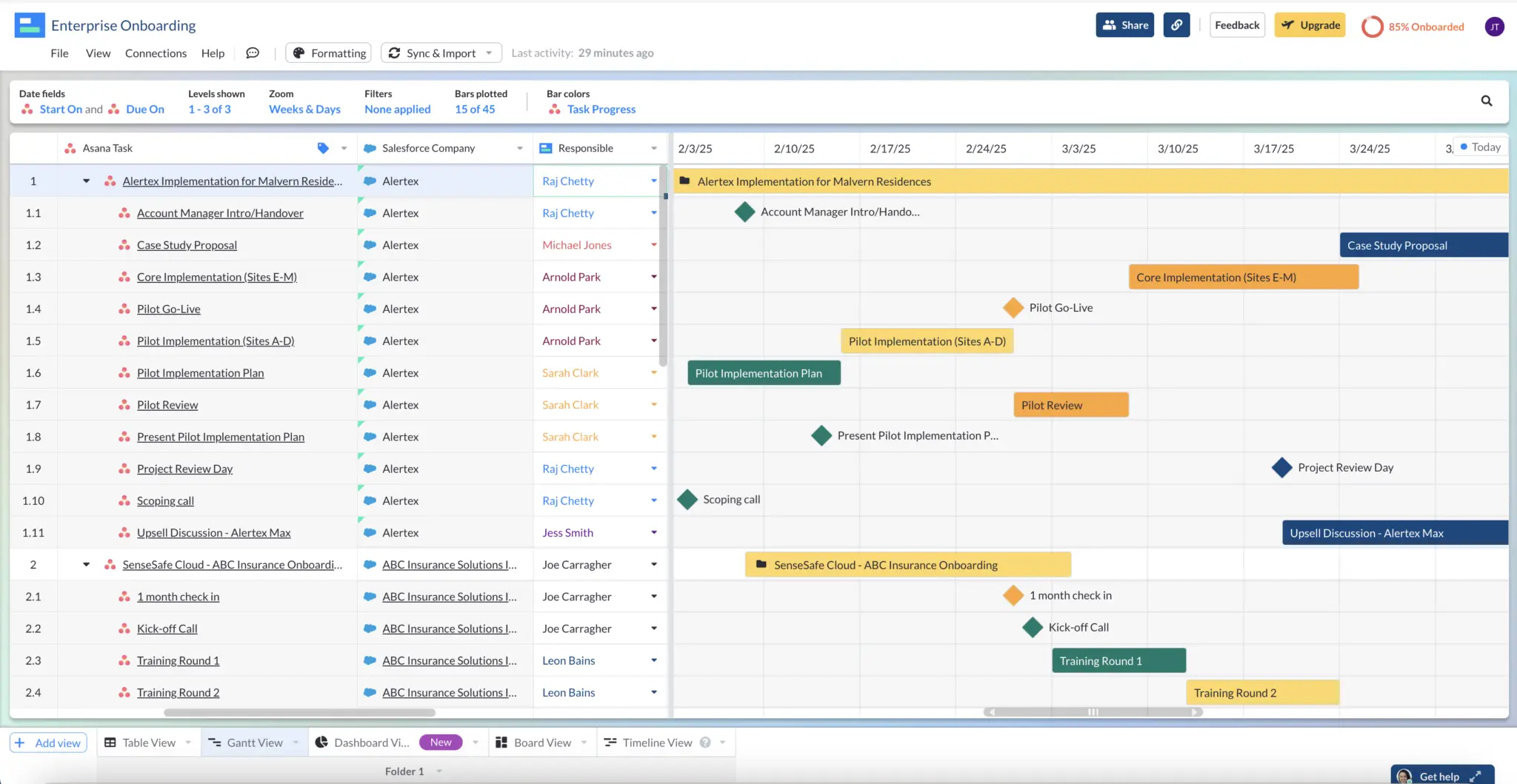
If you want to make the most of using Asana for project management and product roadmapping, you’ll want to familiarize yourself with a few best practices in the area.
Integrations
Asana has a wide range of available integrations, and offers a large app marketplace that you can explore. Regardless of if you need extra security, like Okta, communication options like Slack or Microsoft Teams, and of course the ever-present Asana Jira integration.
One thing to note is that Asana does integrate beautifully with Visor, which fills in several of the gaps Asana has in terms of effective roadmapping.
Pricing
Starter: $10.99 per user
Advanced: $24.99 per user
Enterprise and Enterprise+: Pricing available upon request
5. Prodpad
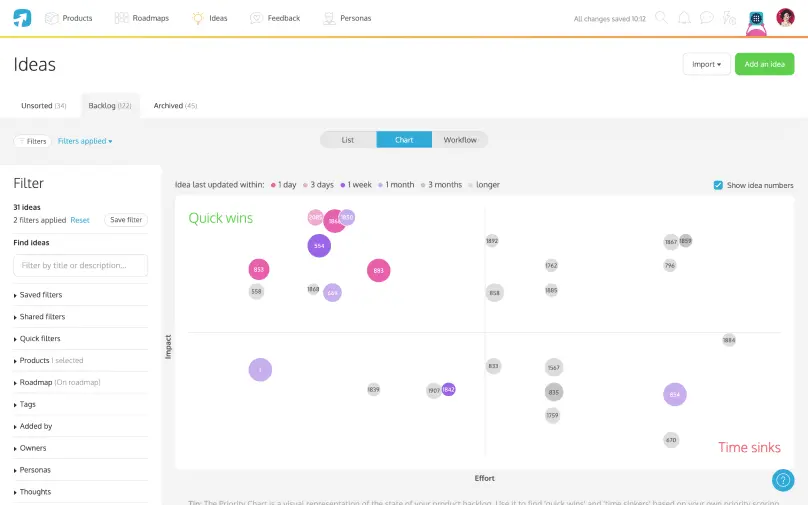
Image via Prodpad
Prodpad’s design gears it for lean product management, rather than agile, which makes it a bit of an outsider compared to the other options on this list. Proadpad’s roadmapping tools are not as advanced as roadmap focused tools like Roadmunk.
It isn’t ideal for traditional, release-based agile processes. But I had to add it to this list to avoid overlooking such a great tool for those working in lean.
Roadmapping
Roadmaps in Prodpad aren’t formatted in timelines, which you would probably expect from a tool that is so lean oriented. Instead you organize features and tasks into three buckets: Now, Next, and Later.
You can tie all of the elements on your roadmap to the organizational or team objective they support. You can also tag roadmap items to different market segments, or functionality areas, such as security, UI, mobile app and so on. This enables you to create sub-buckets of tasks, and multiple views for different purposes.
The relative simplicity of the roadmap framework, coupled with the tagging system, means you can create roadmaps for product portfolios, product lines, and individual products, depending on your team and organization’s approach.
Sharing roadmaps
You can share Prodpad roadmaps using shareable links, or embed codes. You can save unlimited customized views based on your tagging and filtering for different audiences. The Roadmap Essentials module ($24 per editor per month) includes unlimited viewer logins.
Ease of Use
Prodpad has a very simple and clear UI. The navigation menu is not overloaded with a huge number of options, everything is clearly labeled and there’s a really smooth tab-based display for each roadmap. Even new users won’t feel overwhelmed.
Integrations
Prodpad’s modular pricing complicates the integration situation. Integrations with developer tools like Jira are only included with the Ideas Advanced module ($36 per editor per month) and not with either of the Roadmap modules (an additional $24-44 dollars per editor per month).
The integration with Jira only pulls in the Jira backlog, pushes out Prodpad ideas as Jira Issues, and Prodpad user stories as Jira stories. This is still very useful as you can take features from the idea stage to execution stage more smoothly. But it’s much less comprehensive than Jira integration offered by tools like Visor.
Pricing
Roadmaps Essentials: $24 per editor per month
Roadmaps Advanced: $44 per editor per month
Ideas Essentials: $24 per editor per month
Ideas Advanced: $36 per editor per month
6. Productboard
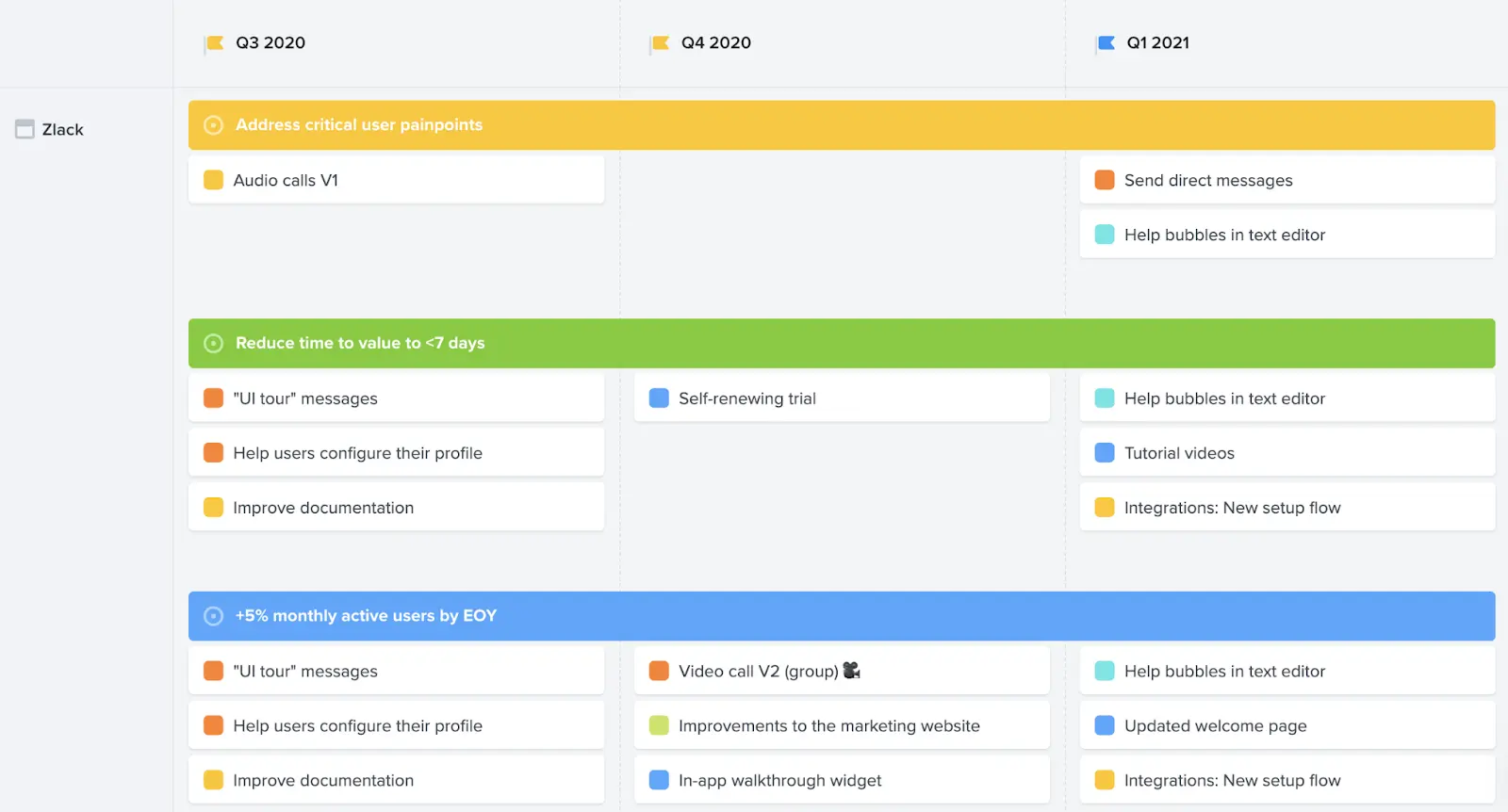
Image via Productboard
Productboard is a feature-rich, technically sophisticated product management tool, of which roadmapping is a substantial element. Productboard is targeted more at larger organizations, with a focus on serving market demand through the application of detailed and well-organized customer feedback. If you have already used Productboard and didn’t like it, you can also read my breakdown of the best alternatives to Productboard.
Roadmapping
Productboard is a little different from the other entries in this list, as its key focus is not roadmapping. However, if you want good, professional roadmaps driven by intelligence sourced from customers and your marketplace, Productboard is the premier choice.
Ideas for features and improvements run through a robust prioritization process, supported by customer feedback. This process creates a repository of rated feature ideas. These ideas can then be seamlessly added to your roadmap while retaining the links to their justification and prioritization.
Productboard supports roadmaps in different formats, including kanban, sprint/release based, and timeline. All of these look clear and clean.
The roadmapping functionality itself is not as sophisticated as roadmap specialists like Roadmunk. But it is certainly a massive step up from using PowerPoint or Excel to represent a roadmap, and better than what you will find in many all-encompassing product management systems.
Sharing roadmaps
Every Productboard plan has unlimited viewers, including their free Starter plan. This is unlike Roadmunk or ProductPlan. Viewers and contributors can comment directly on roadmaps, and you can control the visibility of different items for different roles, teams, or individuals. You can invite viewers to your roadmap using shareable links. You can also share or embed static versions as an image or PDF.
Ease of Use
Productboard is relatively easy to use, but it is still a complex, feature-rich tool that will take new users time to acclimate to, especially if they are not familiar with core project management theories and approaches.
Integrations
Productboard has the broadest range of integrations of any option on this list. Its two-way integrations are included in all its plans, which differentiates it from Roadmunk and Productplan. Integrations include developer tools, messaging, CRMs, and complimentary apps like Miro, Figma, and Mural to support collaboration.
Productboard’s integration with dev tools like Jira is more limited than alternatives like Visor. In Productboard, you can push prioritized features into systems like Jira and Azure DevOps so that they can get actioned seamlessly, which is very useful.
But in Visor, the integration is much more complete and enables you to sync many more types of information and actions between systems like Jira and itself.
Pricing
Essentials: $19 per editor per month
Pro: $59 per editor per month
Enterprise: Pricing on request
Best Product Roadmap Tool for Jira
In order, here’s our verdict on the best product roadmap software available for teams who need to integrate with Jira.
- Visor
- Jira Advanced Roadmaps
- Asana
- Productboard
- ProductPlan
- Roadmunk
Example of Product Roadmap Template created with Visor and Jira Data:
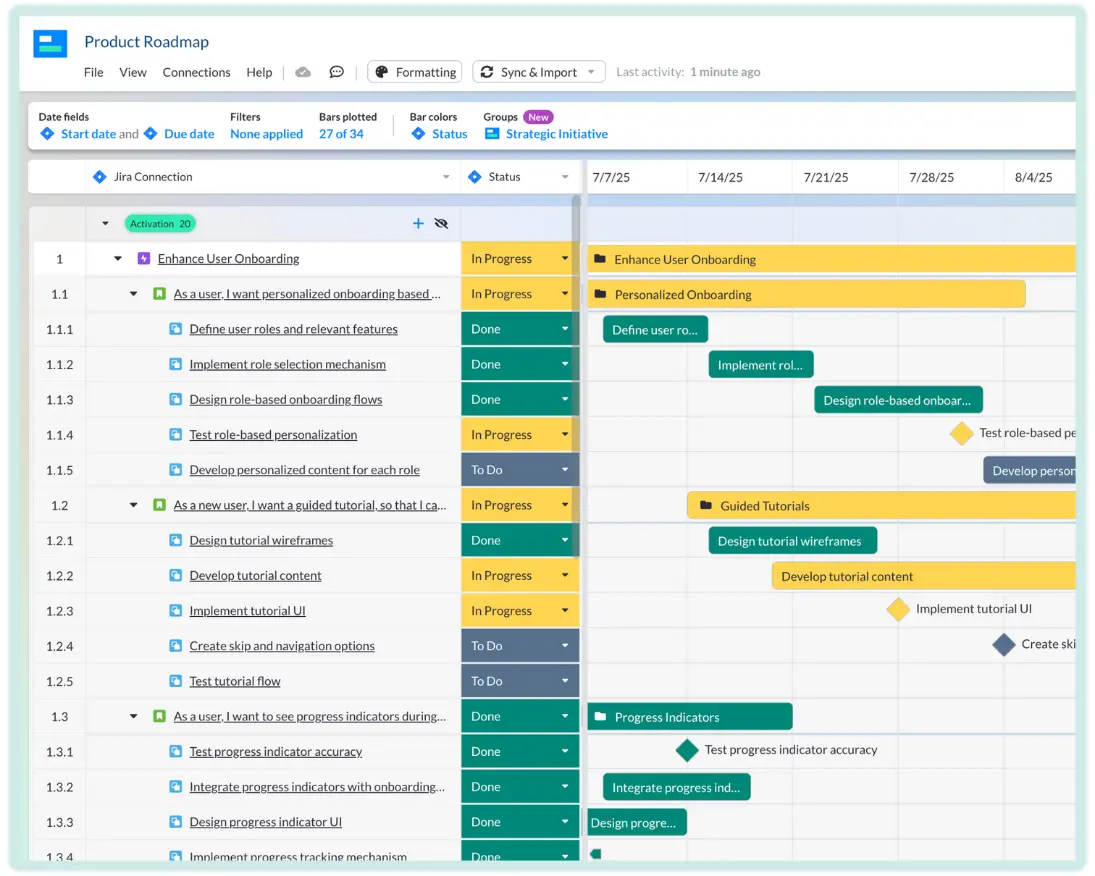
Determining the best roadmap tool for Jira users, or Jira roadmap plugin, requires us to consider a few key factors:
- Does it include a two-way integration with Jira as standard?
- What’s the minimum estimated monthly cost of a two-way integration?
- What information can be synced back and forth between the tool and Jira?
- Does it preserve hierarchies (tasks, sub-tasks, epics, stories etc.)
- How much control do you have over when and how syncs occur?
- Does it support Jira custom fields?
- Does it retain each Jira field’s characteristics (character limits, character types, dropdown options etc.)?
Based on these factors, Visor is the best roadmapping tool for Jira because:
- Visor gives you a two-way Jira integration with every plan, even our FREE plan!
- Compare this with Roadmunk, or Productboard where you would need to pay at least $58, per editor, per month.
- When Visor imports Jira data it preserves the hierarchies in your projects (your tasks, sub-tasks, issues etc.) and relationships between issue types.
- Visor supports Jira custom fields.
- Visor imports field characteristics ensuring both systems match and preventing sync issues.
- You control when syncs happen (including manual vs. scheduled and one-way vs two-way) through simple controls in the app, you can adjust the sync as and when you need to.
Technically Jira’s own Advanced Roadmaps is the most integrated tool (of course) and is a big improvement on the basic Jira Timeline feature (find out why in our breakdown of Jira Timeline vs Advanced Roadmaps). However, many users have pointed out flaws with some of Jira’s built-in roadmapping functionality, as one Reddit users explains in a thread about the best roadmapping tools.
“…don’t use Jira’s idea board… it’ll cause your team to equate user stories or epics into roadmap items.” – from Reddit
The roadmapping functionality in Advanced Roadmaps – and the cost – leaves many users looking for an alternative, as Alex at ApeTechTutorials vividly explains in this brilliant video:
Best Product Roadmap Tool – Rounding Up
I hope that after reading my reviews of the best roadmapping software available, you will have a clearer understanding of the world of product roadmapping tools. Now, you should be able to pick the tool that’s best suited for you and become your perfect partner on your product roadmapping journey.
To help you make that next step and start test driving:
Visor should be the first roadmapping tool you try if you’re a Jira user.
Example of Agile Roadmap Template with Jira Data:

If you’re hoping for a widely-accessible tool that anyone on your team can use without much friction, and you don’t need the most advanced features, Asana will be a good choice for you.
Visor has a lot of Jira-friendly templates for roadmaps, including product backlog templates, project milestone templates, a template for agile release plans, and many more.
If you want an advanced, feature-heavy roadmap tool that incorporates feedback and prioritization, Roadmunk should be your first choice.
If you work in lean and have found other systems a poor fit, then you should try Prodpad.
If you want to keep it simple and don’t care much about integrations with developer tools or integrating feedback and prioritization, try ProductPlan.
If you want a tool that’s focused on gathering, organizing, and utilizing insights from customers and the wider market to drive your product development and roadmap then Productboard is worth a look.
Now that you’re ready to go, give Visor a try first (it’s free!)





